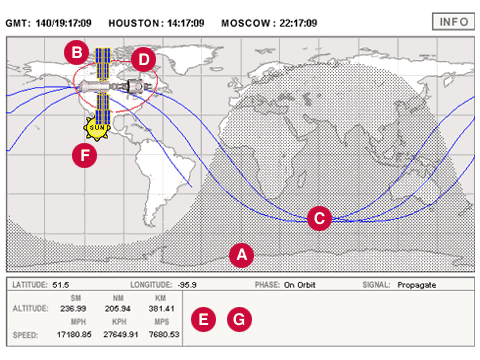|
| Where is the Space Station? |
|
|
Use the NASA ISS Tracker to figure out the International Space Station (ISS) orbit.
The Tracker allows you to follow the Space Station around the Earth wherever it
is.

Go to NASA’s Orbital
Tracking System
How does it work?
Satellites follow the path of the Space Station and send it to computers at NASA’s
Johnson Space Center (JSC) which then sends it to you through the Internet. Using
this system, you can receive information on your computer through the Mission
Control Center.
What information can I get from the Tracker?
(see also:
http://spaceflight.nasa.gov/realdata/tracking/help.html)
(A) |
The map of the world.
|
(B) |
The International Space Station; the center represents its current
latitude/longitude.
|
(C) |
The blue line tracks the International Space Station's path over the
ground.
|
(D) |
The red circle around the International Space Station represents its horizon
(the area on the ground from which the orbiter is visible).
|
(E) |
Header Information: (GMT, Houston and Moscow times are displayed in
DAYS/HOURS:MIN:SEC format.
|
(F) |
The yellow ball represents the Sun's zenith (high noon on earth).
|
(G) |
The Orbital Tracking Application also provides location data on the space
shuttle during missions.
|
GMT: |
Greenwich Mean Time |
Lat: |
Latitude of the orbiter |
Long: |
Longitude of the orbiter |
Alt: |
Current altitude of orbiter in kilometers
|
Spd: |
The Orbiter/Station speed in metres per second
|
Can I see the Space Station from my back yard?
Yes. Using the ISS Tracker to see if the Space Station is over your country, you can
find out what are the Space Station sighting opportunities, which means the dates
and times when you will be able to see the Space Station in the sky.
These dates and times are published by NASA’s Johnson Space Center. Updates occur on
Mondays.
|
